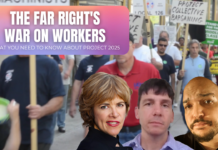From auto plants to Amazon warehouses, to Hollywood studios, pharmacies and hospitals, almost half a million workers have gone on strike so far this year. Many are celebrating this revival of labor power, but what does it mean for workers of color — often hardest hit — and least well treated even by traditional labor organizations? Worker rights and racial justice are linked, but mainstream media often fails to make the connection. In this “Meet the BIPOC Press” episode co-hosted by Laura Flanders and Sara Lomax, Co-founder of URL Media, we explore the diversity of today’s unionized workforce and their demands. What happens when media bring a race-smart angle to their reporting? Joining us are Queens, New York-based reporter Amir Khafagy, reporting on the intersection of labor and immigration at Documented; and News Editor Carolyn Copeland, who is tracking national labor coverage with her team at Prism.
“Whenever you’re talking about unions, you’re always talking about people of color because people of color are more likely to belong to a union . . . Union issues are always a racial justice issue.” – Carolyn Copeland
“We have this sense of the burly Trade Union white guy that sometimes votes Republican. But lately, what we’ve seen now is the trade unions have come to realize that the historical animosity they had, especially towards immigrant workers and Black and Latino workers, has actually hurt their movement.“ – Amir Khafagy
“There has been a generational concern in Philadelphia about the racial gap in access to union participation . . . A lot of Black and BIPOC workers have not been able to join some of the unions in Philadelphia, skilled trades, et cetera. And it’s really created a racial hierarchy in the unions.” – Sara Lomax
THE LAURA FLANDERS SHOW
THE LAURA FLANDERS SHOW
BIPOC MEDIA ON THE FIGHT FOR FAIR WAGES — & ANTI-RACIST UNIONS
LAURA FLANDERS: This year more than 450,000 workers have gone on strike and the action shows no sign of stopping. From auto plants to Amazon warehouses, to Hollywood studios, pharmacies and hospitals, workers have been taking to the streets in the US and many in the labor press are celebrating this revival of labor action. But what does it all mean for workers of color? Often the hardest hit and least well-treated even by traditional labor organizations. And what happens when media bring a race smart angle to their reporting of all these stories. For this month’s episode of our Meet the BIPOC Press feature, I am joined once again by Sara Lomax of Philadelphia’s WURD Radio. She’s one of the co-founders of URL Media, a network of independent media owned and operated by people of color. Great to see you again, Sara.
SARA LOMAX: So good to see you and to be here, Laura. I’m so excited about this conversation. Because for Black people, unions have a history of locking Black folks out from a racial standpoint. And so that was the impetus of the Brotherhood of Sleeping Car Porters that was started by A. Philip Randolph in 1925 to really advocate for Black workers in particular because they were not supported and welcomed into white labor unions. So looking forward to having a discussion about what this means specifically for Black and Brown communities.
LAURA FLANDERS: Well, joining us to continue this discussion, a reporter, Amir Khafagy. He’s on the ground in Queens, New York. He’s reporting on that intersection of labor and immigration and race at Documented and on the West coast from Hayward, California, we have news editor Carolyn Copeland, who’s tracking national labor coverage with her team at Prism, which is an independent nonprofit newsroom run by journalists of color. So welcome both of our guests. I guess I’m going to start with you, Carolyn. Let’s start with the good news. What are workers celebrating as we start this conversation?
CAROLYN COPELAND: Well, I think it really depends on which union you’re referring to. If you’re going to speak about workers at Kaiser, for example, who just secured a contract. 75,000 Kaiser workers across the country went on strike, I think it was a three-day strike. Across the country they just averted a seven-day strike in November, and they made very few concessions. That was a major victory, and that’s something that’s rare in union negotiations and collective bargaining. UPS workers who averted a massive strike. Also, they would’ve been, I think it was 340,000 workers. I might be a little off on those numbers, but not by much. They averted a massive strike. They also didn’t make very many concessions. So that’s a big victory.
SARA LOMAX: How are unions facilitating worker power? Because we know that they haven’t always advocated and really facilitated power when it comes to racial justice and Black power.
CAROLYN COPELAND: Whenever you’re talking about unions, you’re always talking about people of color because people of color are more likely to belong to a union. Black people in particular are more likely to belong to a union. Going back to what we were talking about with the Kaiser strike, more Black and Brown people belong to that union. I think I want to say, I hope I’m getting this statistic right. I think it’s something like 60% of Kaiser Permanente workers were Black or brown. So, union issues are always a racial justice issue. So yes, that’s always at play, and that’s largely, not completely, but largely because unions help bridge the racial wage gap. If you’re asking about how unions are forming in hostile environments, I mean that’s something that we’ve been covering pretty extensively at Prism. For example, we just did a piece on the civil rights nonprofit Color of Change. Our reporter, Alexandra Martinez followed up with reporting on the union busting and how that was hurting their advocacy as a civil rights organization.
LAURA FLANDERS: Let me come to you, Amir. Just for people that are not familiar with the whole idea of collective bargaining and why it matters, you come to this work as I understand it from activism. In principle, how are unions supposed to help workers in those worker employer battles over power?
AMIR KHAFAGY: I often find it that many workers themselves don’t know how union works, unions work in general. They feel that unions sometimes, they don’t have much education about how important unions are in terms of advocating for the workers. So in general, what a union’s supposed to do is really give a collective voice for the workers, right? And it comes from the idea that a worker, a single worker, cannot go to the boss and say, listen, I have all these grievances. I want you to fix my problems and all the issues that we’re having at the workplace. The boss can simply fire that single worker. But if the workers come together as a group and say, listen, we have this collective issue and we need these things to be addressed or we need some sort of change, they have more power in their numbers, thus the boss would be more likely to concede to some of these demands in order to keep some of the workplace peace. So essentially a union, forget all the bureaucracy that has come over the years and stuff. A union is essentially workers coming together, demanding rights in the workplace or are demanding a better workplace.
LAURA FLANDERS: So obviously it’s a problem when certain groups of workers are actually forbidden to belong to unions as Sara pointed out at the top of the show, that’s part of the history of the trade union movement. But you wrote as recently as 2020 about workers coming together, making demands and finding themselves stalled or blocked not only by the industry, but by the union that’s supposed to represent them.
AMIR KHAFAGY: Yeah, sometimes unions don’t always represent the best interest of the workers, and that’s why the union democracy movement is very important that doesn’t get much coverage in themselves. So there are movements, especially like in New York with the home care workers who were fighting against their own unions, SEIU, and they were demanding, listen, we don’t want this 24 hour workday. This is exhausting for us. This is killing us slowly, and we want some sort of law that gets passed, some legislative law because they didn’t have any confidence that the boss would just end 24 hour workday because that’s an industry-wide standard and demanding legislation to address this. And they found that their own union was blocking that. So they were going against their own union even going so far as suing their own union to get their rights.
LAURA FLANDERS: And what happened? How did the union respond?
AMIR KHAFAGY: They essentially tried to kill the bill and they were lobbying heavily at city hall. It was a city bill and they had a rally outside city hall. The union themselves, while the workers were protesting, demanding the passage of this bill, the union was across the street, having a chant, “kill the bill, kill the bill.” And it was really demoralizing for a lot of the workers who belong to that union.
LAURA FLANDERS: Has anything changed? I just have to find out, has anything’s changed since 2020?
AMIR KHAFAGY: They’re still fighting. There’s a state law and there’s a city law that they’re trying to push, and they’re coming against a lot of opposition. So it’s still ongoing and they’re still fighting.
SARA LOMAX: There’s a lot of unionization activity right now and union activism. What is the differentiator between those actions that are working and those that are not, are not actually resulting in actual benefits for the members?
AMIR KHAFAGY: It’s a bit complicated. So a lot of what we’re seeing at Starbucks, right? It seems to be a lot of younger, new people coming into the union movement. They’re kind of interjecting a new sense of energy and a new sense of identity into these union movements that are happening because they don’t have the burden of the legacy unions coming in and kind of imposing what’s possible. I think what’s a great example of what was possible was what happened in Amazon, right? That was an independent union movement on Staten Island in New York City where the workers rejected a mainstream union coming in and telling them, hey, you can’t do this, you can’t do that. They said, well, we have a direct relationship with the workers because we are the workers and it was successful. They have struggles now, there’s a lot of internal struggle in terms of how to get a collective bargaining agreement, which is very complicated in of itself. But they were successful in the sense that unions have often struggled to organize places like Amazon and Walmart for various reasons. And I think one of the main reasons was they just really didn’t have people on the ground inside these workplaces meeting the needs, the day-to-day needs of the workers. But what the Amazon Labor Union was able to do is to say we are the workers. We know the day-to-day needs of what the workers need and want and demand. And they were able to address that and relate and build a union there.
LAURA FLANDERS: Coming to you, Carolyn, you see everything that comes through the news desk there at Prism that has to do with labor. And I was struck by how many stories are not actually about trade unions. So can you talk about how else workers are improving their conditions?
CAROLYN COPELAND: One main thing that we’ve been reporting on lately, or one story that we’ve been following I should say, is the heat protections that workers in Miami have been fighting for. Outdoor laborers have been pushing for a heat ordinance that could become the first in the country. And outdoor laborers, meaning gardeners, farmers who are not even allowed to take breaks to have a sip of water. Some are not even allowed to drink water or go to the restroom. Or not even allowed to drink water because it would cause them to go to the restroom. And so they’re trying to outlaw that, and that would be the first countywide ordinance like that in the entire country. So that’s one way they’re pushing for it, but we’re seeing things like this all across the country.
SARA LOMAX: What are the responses from the corporations and management? We know that there’s union busting happening, but I’m curious also, how are… Are some organizations, as these movements continue to expand, doing things to thwart or to avoid proactively union walkouts or activations?
CAROLYN COPELAND: Well, there are a lot of things that corporations are doing to union bust. One thing that happens a lot is captive audience meetings. Mandatory meetings to discourage unions or just talk about how bad they are. Another thing that people do is just to thwart the forming of a union, but when a union is already formed, maybe they’ll start giving benefits to other people outside of that to sort of discourage new employees from joining the union. They’ll cut hours, they will close down stores. They also will hire law firms to minimize union power. We’re seeing that with companies like Starbucks as well.
SARA LOMAX: I am based in Philadelphia. I run a Black talk station in Philadelphia, and there has been a generational concern in Philadelphia about kind of the racial gap in access to union participation. There has been, and that has been identified as a reason for maintaining kind of the racial wealth gap that a lot of Black in particular workers have not been able to join some of the unions in Philadelphia, some of the skilled trades, et cetera, and it’s really created a racial hierarchy in the unions. And so I’m just curious, and maybe I’ll throw this to Amir. You’re in New York City, you’re working with Documented. I’m wondering if you are seeing anything like that happening in terms of access to the unions contemporarily?
AMIR KHAFAGY: New York and Philadelphia are sister cities. So the conditions in Philadelphia are probably very similar to New York. Workers Centers have historically been a great way for workers who have not been organized into traditional unions to assert some of their collective rights as workers. The Laundry Worker Center, which organizes laundry workers is another great example of a worker center really reaching out to workers that haven’t been into the, who have been excluded historically from the mainstream unions and giving them a sense of power and collective rights. What I’ve been seeing in New York is very interesting. Historically, the trade unions have been some of the most exclusionary unions when it comes to Black and Latino workers. They oftentimes have been traditionally Italian, Irish workers that pass the jobs along generationally, right? We have this sense of the burly trade union, white guy that sometimes votes Republican. That’s the sense we get. But lately what we’ve seen now is the trade unions have come to realize that their historical animosity they had, especially towards immigrant workers and Black and Latino workers in general, has actually hurt their movement, right? Because what happened was that the fact that they excluded those groups from their unions allowed exploitative contractors and employers to take advantage of that by hiring Black and Latino workers, paying them less and giving them worse working conditions. But because those workers couldn’t join a union, they would take those jobs because it was the best opportunity they had to even get a construction job in the first place, thus lowering the standards for all workers in that industry as a whole.
SARA LOMAX: I’m curious if both of you can speak to the impact in the aftermath of the pandemic, how that has either ramped up or impacted union organizing for workers who might’ve really felt the pain and the disproportionate impact on them during the pandemic.
CAROLYN COPELAND: When the pandemic started in 2020, a lot of people were branded as essential workers, and they sort of looked around and they realized that even though they’re branded as essential workers, they’re bagging groceries for people and putting their lives on the line, but they’re being paid just above minimum wage. They are not able to take time off when they’re sick, when their partner’s sick or when their child’s sick, and they’re not being respected in the workplace. And so that right there sort of became a ripple effect, and it caused people to want to sort of fight for their rights in the workplace or to when it became time to fight for a new contract, to put new things in it. And so that’s sort of when the labor movement ramped up, and you’re seeing that across different industries as well with lots of different layoffs that are happening across industries, with massive layoffs across the country. Remote work also has changed the landscape of the economy as well. So I mean, the pandemic really changed everything about employment and organizing as well. So we know that unionizing has skyrocketed just in the past couple of years.
LAURA FLANDERS: What are you seeing as the impact on the labor movement and the labor organizing that you see of the fact that finally in 2000, the AFL-CIO executive board decided to reverse its position on immigration and support legal roots to citizenship for undocumented workers? What difference has that made to this moment, do you think?
AMIR KHAFAGY: Historically, especially the AFL-CIO has had a very anti-immigration stance. They often saw immigrant workers as competitors with people born in the United States, and they often took a very right wing position when it came to immigration. This reversal has really expanded the scope of what’s possible in terms of organizing and embracing immigrant workers. Because when we talk about immigration, it’s always a labor conversation, and that gets lost in the messaging. When we hear about immigration, it’s always about labor if you notice that. Even now with the asylum seeker crisis happening in New York, now we’re having this conversation about work permits and so on. Labor and immigration are interconnected. They’re not two separate issues. Oftentimes the right wing talking points about immigration is, oh, they’re taking jobs away from Americans, and so on and so forth. So that whole language and all those concerns and everything else is all mucked up within a labor context. I think the AFL-CIO realized that the standards were being lowered across the board because their exclusionary rules that they had, that barred organizing undocumented workers and immigrant workers in general, really hurt workers throughout the country. And it really brought down the standards for everybody. And I think now they’re realizing, listen, this was a tactic and this was an idea that we had that really wasn’t working, and it was hurting us, and it was hurting the labor movement, and we really now have to embrace them. Contrary to public knowledge and a lot of people don’t even know this, even within the labor movement, that undocumented workers have a right to join unions. There’s no law that says that undocumented workers cannot be in a labor union. So I think now we’re seeing, hey, wait a minute. We have to really embrace this cohort of workers because there there’s millions of undocumented workers making subpar wages who are just yearning to be organized, and that would really improve labor conditions for everybody.
LAURA FLANDERS: I just want to put a pin in the fact that the labor movement, the workforce of this country has changed demographically speaking and that eroding white male supremacy has meant there are new people in power in some trade unions. That it seems to me is kind of the underreported story of this moment. The labor movement is changing in the way that you’ve described. It’s also changing in its demands with more struggles around. You mentioned Carolyn, the heat. You’ve also mentioned water breaks and so on, environmental justice, racial justice, housing, student debt. I mean, we’re seeing everyone from teachers in Chicago to teachers in West Virginia raise these, I think they’re called common good demands that didn’t come from just nowhere.
AMIR KHAFAGY: Yeah, labor movements have been in decline for years, right? In the 1950s, almost half the work places in this country were organized, and now almost none are organized. So we’re seeing a really big shift in what’s possible now with especially these new industries forming of people demanding new conditions such as getting air conditioners in their trucks or having water breaks. Things we wouldn’t traditionally think that unions would demand. But unions have in their own way kind of stunted their own growth by only sticking to small demands, just like a modest pay increase here or there, some modest increases in health insurance, but that’s it. A lot of the unions, in fact, have been kind of blocking efforts to try to get universal healthcare because they have a lot at stake with their own insurance companies. So a lot of the time the unions and the workers were not connected. There was no conversation between the rank and file and the union bureaucracy. But now we’re seeing a brand new demographic of people in the unions, not only in race, but also by age. A lot of young people are interested in unions and going into unions, and they’re changing the conversation and demanding more than what unions were traditionally offering and changing the conversation of what is possible.
SARA LOMAX: I’m curious, Carolyn, to you, we’ve talked a lot about the racial dynamics, but there’s also gender dynamics because as Laura mentioned, the stereotypical kind of demographic was kind of like the white male union worker. But we are seeing a lot more women in positions of power and positions of leadership in unions now.
CAROLYN COPELAND: We know that women disproportionately, and specifically women of color disproportionately have to deal with the burdens of the home, or they’re more likely to live in intergenerational households and carry the burdens of that. But we don’t see that a lot when it comes to bargaining, at least not right now, and at least not, it’s not widespread. But one of the things that unions are asking for a lot right now is time off. So that is something that would impact women, but we’re not seeing a lot of increased demands for paid parental leave. And that’s something that we’re seeing that at the national level that people are calling for, but not so much union by union. So that’s something that we obviously hope to see more of as time passes and as more people unionize and maybe as their next contracts come up, that’ll be something they prioritize.
LAURA FLANDERS: The sad story is we don’t have enough labor beats in this country. Period. But you’re doing this reporting, how do you frame this work, and what would be your kind of learnings to your colleagues in the industry? What do they need to be doing differently?
CAROLYN COPELAND: It’s easy to do this work and sometimes come across as extractive when you’re trying to get this information from people or you’re mining them for information for a story. But to really build trust and to put a worker centered story out there and to publish it and to give it time, you really have to build those relationships, and that’s how you make a really personal, relatable, important story. And that’s how you put that together is by forming those relationships. And that’s how you get a reporter like Amir, reporters like we have at Prism. And I think that that’s what more journalists need to do, especially journalists that you see at the national level. I see that a lot from independent journalists, but not as much from people in the mainstream because they’re, I think a lot of times, trying so hard just to get the story out, to get it first. And not so much thinking about the impact that it has on the people that they’re some, kind of exploiting.
AMIR KHAFAGY: I try to follow worker struggles as it progresses. I try to find unique angles to things that other reporters might report on as a breaking news, and I try to find the deeper story behind that. And that’s kind of my guiding principle when I do this reporting. I always think about the workers themselves, not just the academics or the bureaucrats or the politicians. I try to center their voices above all.
LAURA FLANDERS: Sara, any closing thoughts from you? What do you think A. Philip Randolph would be thinking of this moment?
SARA LOMAX: So often I find mainstream reporting about these movements is very much just about management versus the workers, and I feel like today’s conversation was very much looking at the complexity within the union structures and centering the workers is always at the core of reporting, like Documented and Prism’s and the work that many of our URL media outlets are pursuing. We are looking at these issues from a different vantage point than maybe from the mainstream media’s perspective.
LAURA FLANDERS: Well, thank you for that. And I want to thank all of our guests, Amir Khafagy, Carolyn Copeland, thank you so much for being with us.
For more on this episode and other forward-thinking content, subscribe to our free newsletter for updates, my commentaries and our full uncut conversations. We also have a podcast. It’s all at lauraflanders.org.
“Making Good Trouble on Staten Island: Chris Small’s Battle to Unionize Amazon” by Amir Khafagy Learn More/Get the Book
“The Surge” by Sandunes featuring Ramya Pathuri, from their full length album The Ground Beneath Her Feet, released on Tru Thoughts records. Listen & Learn More Here
The Laura Flanders Show is committed to making our programming, website and social media as accessible as possible to everyone, including those with visual, hearing, cognitive and motor impairments. We’re constantly working towards improving the accessibility of our content to ensure we provide equal access to all. If you would like to request accessibility-related assistance, report any accessibility problems, or request any information in accessible alternative formats, please
















